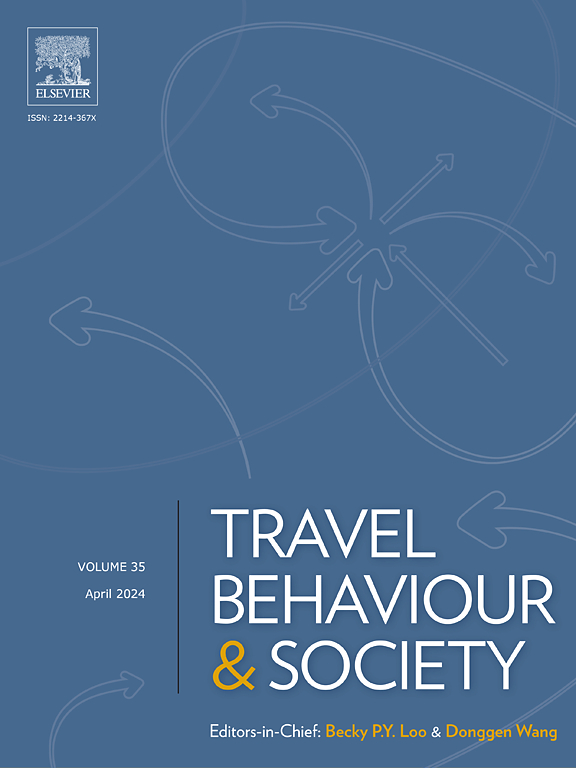The effects of a real-time public transport information app on travel behaviour, traffic levels and the environment
IF 5.7
2区 工程技术
Q1 TRANSPORTATION
引用次数: 0
Abstract
Advanced Traveller Information Systems (ATIS) have been shown to improve travel satisfaction and to make public transport more attractive, but their effect on traffic, travel behaviour, and environmental externalities remains an open question. Addressing these questions is key to determining the impact of policies supporting ATIS in sustainability outputs. In this paper, we study the case of Red, a nationwide real-time public transport mobile application in Chile. Through a survey conducted on the app, we analyse the effects that the use of the app has on modal choice, public transport demand, vehicle kilometres travelled (VKT) and environmental externalities. One of the surveys questions was the counterfactual mode: we asked participants which mode they would have used in their latest trip if they did not have access to the app. Contrasting this with the revealed mode used in the latest trip, allowed us to estimate the modal substitution rate. We performed Monte Carlo simulations to estimate the Red effect on total VKT and environmental pollution. We find that: (i) when using Red, perceived waiting time decreased and personal security improved, (ii) 23.5% of the Red users changed their travel behaviour: 10.5% changed travel mode change and 13.6% chose another bus route or bus stop because of using Red (iii) urban buses gain and lose passengers (3:2 ratio, with a net increase in demand), competing mainly with shared taxis and ride-hailing, (iv) the induced demand for public transport is 1.1%, (v) the app reduces total VKT (probability ), and emissions (88%), and (vi) variation on local air pollutant emissions depends on vehicles environmental standards, decreasing only under high standards (Euro VI). Our method was applied to the case of an ATIS app, but is suitable to analyse the sustainability effects of any policy that increases public transport demand.
实时公共交通信息应用程序对出行行为、交通水平和环境的影响
先进的旅行者信息系统(ATIS)已被证明可以提高旅行满意度,并使公共交通更具吸引力,但它们对交通、旅行行为和环境外部性的影响仍然是一个悬而未决的问题。解决这些问题是确定支持ATIS的政策对可持续性产出的影响的关键。在本文中,我们研究的案例红色,一个全国性的实时公共交通移动应用程序在智利。通过对该应用程序进行的调查,我们分析了使用该应用程序对模式选择、公共交通需求、车辆行驶公里数(VKT)和环境外部性的影响。其中一个调查问题是反事实模式:我们询问参与者,如果他们没有访问应用程序,他们会在最近一次旅行中使用哪种模式。将其与最近一次旅行中使用的显示模式进行对比,使我们能够估计模式替代率。我们通过蒙特卡罗模拟来估计红色对总VKT和环境污染的影响。我们发现:(i)当使用Red时,感知等待时间减少,人身安全性提高;(ii) 23.5%的Red用户改变了他们的出行行为;10.5%的人改变了出行方式,13.6%的人选择了另一条公交路线或公交站点,因为使用了Red (iii)城市公交获得和失去了乘客(3:2的比例,需求净增加),主要与共享出租车和网约车竞争,(iv)公共交通的诱导需求为1.1%,(v)应用程序减少了总VKT(概率P=0.99)和二氧化碳排放量(88%),以及(vi)当地空气污染物排放量的变化取决于车辆的环境标准。只有在高标准(欧六)下才会减少。我们的方法应用于ATIS应用程序的案例,但适用于分析任何增加公共交通需求的政策的可持续性影响。
本文章由计算机程序翻译,如有差异,请以英文原文为准。
求助全文
约1分钟内获得全文
求助全文
来源期刊

Travel Behaviour and Society
TRANSPORTATION-
CiteScore
9.80
自引率
7.70%
发文量
109
期刊介绍:
Travel Behaviour and Society is an interdisciplinary journal publishing high-quality original papers which report leading edge research in theories, methodologies and applications concerning transportation issues and challenges which involve the social and spatial dimensions. In particular, it provides a discussion forum for major research in travel behaviour, transportation infrastructure, transportation and environmental issues, mobility and social sustainability, transportation geographic information systems (TGIS), transportation and quality of life, transportation data collection and analysis, etc.
 求助内容:
求助内容: 应助结果提醒方式:
应助结果提醒方式:


